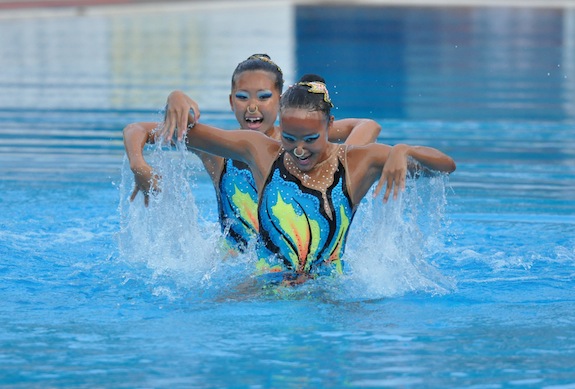Synchronized Swimming is Really Hard, and Really Weird
Olympic synchronized swimmers get a lot of flack for their wacky sport - but while it is weird, it’s also really hard.

Chen Mei Qi Stephanie and Yap Yu Hui Crystal compete in the Southeast ASian Swimming Championships this year. Image: Singapore Sports
In 1985, Martin Short and Harry Shearer took to Saturday Night live to show that they, too, could be synchronized swimmers. Their act, below, won no fans in the synchronized swimming world. That’s because synchronized swimming, despite its makeup and bows and, well, weird acts, is actually really, really hard.
Here, Time sends a reporter to find out just how hard synchronized swimming is.
And yes, the sport is really strange too. The New York Times reports on some of the acts:
One team wore bathing suits decorated with a picture of what appeared to be an owl dressed in a tuxedo. Another began its routine with the athletes lying, inert, by the side of the pool. And in an homage to the Mexican artist Frida Kahlo, a third team, the synchronized swimming duet from Italy, tried to imagine how it might look to descend into madness while performing intricate leg maneuvers upside down in an Olympic swimming pool.
“We imagine there is a mirror, and she is getting ready, and then she goes crazy,” said Giulia Lapi, one of the Italian twosome, said of the artist. “She had a serious accident and she was covered in plaster and had to paint using a mirror.”
If you’ve never watched synchronized swimming, you’re probably not alone. But you’re also missing out on just how synchronized it really is. Swimmers walk to the pool together, with the same, strange gait. They put their nose plugs in at the same time. They dance on the deck, pose, and then dive in. For a long time, all you see is legs doing things you’re not entirely sure of. And they’re doing most of these moves upside down, heads pointed at the bottom of the pool.
This is where a lot of the challenge comes in. This upside down maneuvering is both physically challenging, and must be done while the swimmers hold their breath. Sometimes swimmers pass out. Mariya Koroleva, one of the US’s swimmers, explained it to the New York Times this way: “It’s like running a sprint for three and a half minutes while periodically holding your breath. It gets pretty scary. Your mind and body get completely numb, and you lose the ability to think because, basically, you don’t have enough oxygen.”
Plus, because synchronized swimming doesn’t have the fan base of, say Michael Phelps and swimming, keeping the team together is a challenge. Some sports get a lot of support from the U.S. Olympic Committee. Synchronized swimming is not one of them. They have to raise over 50% of their annual budget themselves.
Time reports that synchronized swimmers really do get the short end of the stick when it comes to Olympic funding:
No athletes, however, have faced a more unusual path to the Olympics than the synchronized swimmers, which isn’t shocking given the oddball nature of the sport. Six members of the senior national team honed their skills at the Aquamaids Synchronized Swimming Club in Santa Clara, Calif. In exchange for resources like coaching, pool time and a travel budget for meets, for every trimester they trained at Aquamaids, the swimmers had to log 100 hours of labor at the 20,000-sq.-ft. bingo hall that generates more than 90% of the club’s $2.4 million annual revenue.
Think of synchronized swimming this way. Put on makeup and a strange, skimpy bathing suit. Jump into the deep end of the pool, stick your head underwater, and hold your breath. Now execute a gymnastics routine for three minutes. Oh yeah, and you have to smile. Do this after spending the whole day selling bingo cards to grumpy customers. Now go pick on another sport.
More at Smithsonian.com:
Hybrid Sports in a League of Their Own
How Olympians Could Beat the Competition by Tweaking Their Genes
/https://tf-cmsv2-smithsonianmag-media.s3.amazonaws.com/accounts/headshot/Rose-Eveleth-240.jpg)
/https://tf-cmsv2-smithsonianmag-media.s3.amazonaws.com/accounts/headshot/Rose-Eveleth-240.jpg)